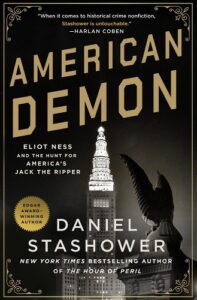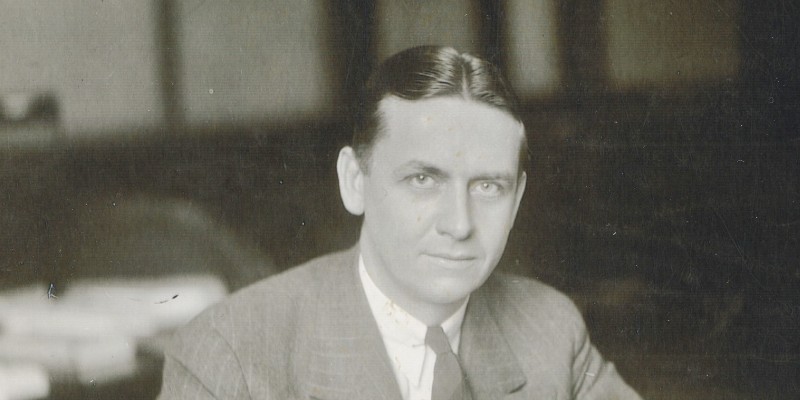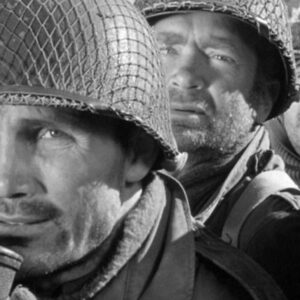For about three years, beginning in 1936, Eliot Ness kept tabs on my grandfather Fred P. Stashower. According to information in Ness’s possession, Fred P. Stashower was “an old egg-tossing vandal.” This, I admit, was news to me.
Eliot Ness, who rose to fame during the Prohibition era as “the man who got Al Capone,” kept tabs on a lot of people. His private papers, now preserved at Cleveland’s Western Reserve Historical Society, feature a rogue’s gallery of bootleggers, rumrunners, racketeers, and gangsters of all stripes. Scrapbooks from his Chicago days chronicle his storied career as the leader of “the Untouchables,” the legendary team of Prohibition agents who smashed up Al Capone’s illicit breweries. “Eight Agents Caught Capone,” reads one clipping. “Eliot Ness, On the Spot, Escaped Death.” There are also images of their famous battering-ram truck, rigged up with a heavy steel prow to crash through the doors of the “alky kitchens” that fueled Capone’s multimillion-dollar empire. There’s even a newspaper artist’s rendering of an enraged Capone swinging a baseball bat over his head, preparing to crack open the skull of a mob turncoat.
Still, as I flipped ahead in the scrapbooks, it became clear that the Untouchables formed a surprisingly narrow slice of Ness’s career. We’re often told that there are no second acts in American lives, but Ness, whose career in Chicago ended at the age of twenty-eight, badly needed one. He found it, after a couple of years in the wilderness, as director of public safety in Cleveland, a position that placed him in charge of the police, fire, and building departments of America’s seventh largest city. “Most of the veteran policemen were cynical and didn’t believe Ness was for real,” one local reporter would recall. “The politicians of both parties were sure he was an overpublicized tyro, a Boy Scout built up by the newspapers, who would soon fall on his face.”
There was reason to think so. Ness was the youngest safety director in the history of any large city, and he arrived in Cleveland at a particularly turbulent moment. The city had been an industrial powerhouse in the 1920s, but all progress halted as the effects of the Great Depression took hold. “Cleveland coasted downhill at dizzying speed,” a city historian would note.
Worse yet, the Depression created a vacuum in which the underworld thrived. During the Prohibition years, Cleveland became a major hub of bootleg liquor and its “sinister offshoots,” including high-stakes gambling, prostitution, and racketeering. This, in turn, gave rise to a web of graft that ran through every level of the city’s government and police force. Things got so bad, according to Clayton Fritchey of the Cleveland Press, that policemen were expected to “tip their hats when they passed a gangster on the streets.”
From his first day on the job, Cleveland’s new “top cop” chipped away at an entrenched system of bribes and payoffs. Ness took an aggressive, hands-on approach, insisting that he would not be a “remote director,” chained to a desk at city hall. “I am going to be out,” he said, “and I’ll cover this town pretty well.” Not only that, he promised, “I will do undercover work to obtain my own evidence and acquaint myself personally with conditions.” In truth, the odds of Ness going undercover were slim. His face appeared on the front pages of the city’s newspapers almost daily, making him easily one of the most recognizable figures in town. In case anyone missed the photos, reporters were quick to embellish, often dwelling on his boyish good looks. “He is about 5 feet 11½ inches tall, weighs 172 pounds, has a mop of unruly brown hair which he futilely attempts to keep parted,” the Press observed. “His eyes are blue and keen and his complexion ruddy. He is trim and athletic. He looks more like a collegian than an expert criminologist.”
His looks were deceiving. Day after day, for months at a time, Clevelanders awoke to read of some fresh feat of derring-do from their young safety director. Ness had kicked open the doors of an after-hours gambling parlor while the city slept, or cracked down on an extortion racket, or rousted a crooked precinct captain. “There was never anybody like him,” said one admirer. “He really captured the imagination of the public in his early years, and he was given a hero’s worship.”
But there was one stubborn blot on his otherwise flawless record. Beginning in 1934, and continuing on Ness’s watch, a string of brutal murders staggered the city. The killings were utterly without precedent—so grisly and shocking that they came to be called “a real-life ‘Murders in the Rue Morgue.’ ” Though Cleveland had seen more than its share of violent crime, being nearly as “mobbed up” as Chicago and New York, these murders were chillingly exceptional. Each of the victims had been beheaded—some, it appeared, while still alive. The remains, in most cases, were painstakingly dismembered and scattered across the city.
The horror took many forms. A pair of schoolboys would stumble over a headless torso, or a hacked-off section of an arm or a leg would be spotted floating down the Cuyahoga River, or a severed head would appear in a city dump. Each atrocity touched off a fresh cycle of fear, outrage, and calls for action, with thunderous headlines such as “The Mad Butcher Strikes Again” and “Who Is This Mad Torso Killer?” Fifty years earlier, the entire world had recoiled as a series of horrific crimes unfolded in London’s Whitechapel district. Now, it seemed, an unnervingly similar note of terror had been struck in America. “Cleveland’s Torso Killer,” read one national headline, “Slays in Same Manner as Jack the Ripper.”
There were many parallels, certainly, but also troubling inconsistencies that posed a challenge to investigators. No pattern could be seen in the tally of the dead—there were men and women, blacks and whites, straights and gays. The victims, when they could be identified at all, were found to be indigents, drifters, or prostitutes—people who would not be missed. Some were known to have been living rough in the hobo jungles of Kingsbury Run, a dried-up riverbed that cut across the city’s southeast side. This gloomy no-man’s-land—a patchwork of trash heaps, cooking fires, and pools of industrial sludge—served as the killer’s hunting grounds.
Cleveland’s detective bureau launched a massive effort, putting in hundreds of hours of overtime. When conventional methods failed to bring results, they pushed themselves to devise fresh ones. A veteran detective named Peter Merylo even set himself out as bait, disguised in hobo gear, but the killer remained elusive. Many hoped that the investigation had reached a turning point when Eliot Ness took personal charge in September of 1936, but the “scientifically-trained investigator” appeared just as flummoxed as the army of detectives under his command.
“Ten times in Cleveland a mad headsman has killed—and 10 times he has dissected with consummate skill the body of his victim,” wrote a Cleveland Press reporter at the height of the drama. “Ten times, indicating skill at surgery or efficiency at butchery, he has baffled police so completely that today there is no tangible clew to the killer. What is he like, this ghoul who delights in cutting up the bodies of men and women, leaving legs and arms and heads and torsos to be found by small boys, bridge watchmen, chance passersby?”
As the death toll continued to climb, Ness found himself besieged. “I want to see this psycho caught,” he declared, but nothing in his training or experience had prepared him to track a serial killer—the phrase itself had yet to be coined. As pressure mounted, Ness grew edgy and frustrated. Capone had been nailed on a technicality: a strict interpretation of the United States Tax Code, the most rigid and banal set of rules in existence. This time, the rule book had yet to be written. Ness faced a criminal who not only flouted the law but whose motives were only dimly understood.
Here was a problem that couldn’t be solved with a steel-nosed truck.
***
For the past three years, I’ve had an Eliot Ness action figure on my desk. Also, an Eliot Ness Transogram board game and a graphic novel featuring Ness and Batman. Ness, I’ve come to learn, comes with a whole lot of pop culture baggage. He’s a maddeningly slippery figure, and it’s often difficult to separate fact from fiction. Even the year of his birth is a subject of debate.
Much of the hyperbole surrounding Ness springs from the pages of The Untouchables, a rock ’em, sock ’em potboiler of a memoir published in 1957, in collaboration with sportswriter Oscar Fraley. The dialogue sounds like an Edward G. Robinson gangster flick: “We walked up to these goons and that one with the shiner started for his roscoe.” Ness has been roundly criticized for the book’s many exaggerations and inventions, but at least some of these embroideries originated with Fraley. Among Ness’s papers, there is a copy of a long memo that he sent to his collaborator, laying out the “background and incidents of the Capone case.” The writing is awkward and scattershot, but over the course of a dense twenty-three pages, Ness gives a largely unvarnished account of himself and his part in the drama. He takes pride in the dangerous work done by the Untouchables, but he also provides a clear-eyed assessment of his role as a supporting player in a larger, multipronged effort to bring down Capone. By the time Fraley recast this raw material into book form, however, Ness had become the central figure of the campaign, a square-jawed hero who all but lassoed Capone from the back of a galloping horse. Ness expressed discomfort over the book’s many excesses, but he did little to moderate them. By that stage, he needed the money.
In time, The Untouchables provided grist for a wildly popular television series starring Robert Stack and, later, a landmark film directed by Brian De Palma from a script by David Mamet. These portrayals carried Fraley’s extravagances to fresh, lofty heights. It may be sufficient here to say that the real Eliot Ness did not throw the gangster Frank Nitti off the roof of the Chicago Federal Building. More than thirty years later, however, everyone remembers that scene from the movie: “He’s in the car.”
It’s easy to see why this version of Ness, a smooth amalgam of Dirty Harry and Atticus Finch, resonates so deeply with people. He’s the embodiment of two-fisted justice, so much so that it’s even claimed he served as the model for Dick Tracy, the straitlaced supercop of comic strip fame. Few people, myself included, are immune to this appeal. I grew up on the Untouchables TV series. Or, more specifically, I spent rainy afternoons watching fuzzy, flickering reruns on Cleveland’s Channel 43, with the rabbit ears on our Hotpoint TV carefully set to ten and two. The character on-screen seemed inextricably linked to Chicago, as much a part of the landscape as Wrigley Field. I knew even then that Ness had a Cleveland connection, but the details remained fuzzy.
I was born and raised in Cleveland. I delivered copies of the Cleveland Press from the basket of my Schwinn Sting-Ray, and I still have my membership card for the Bernie Kosar Quarterback Fan Club, #1064. That was a tough time to be a Clevelander. Our river caught fire. So did our mayor, the unfortunate Ralph J. Perk, who somehow set his hair alight with an acetylene torch at a metalworkers’ convention. Mistakes were made.
Still, when I went looking through Eliot Ness’s scrapbooks at the Western Reserve Historical Society, I felt a certain amount of hometown pride. At first glance, his papers make for a strange mishmash, especially as the young Chicago gangbuster slides into a corner office at Cleveland’s city hall. Intriguing glimpses of his police-cleanup effort, with headlines such as “Ness is Nemesis of Crooked Cops,” are jumbled in with blueprints for a newfangled “coin-in-slot parker,” later known as a parking meter. Oddities abound. There’s a letter from the “King of Hoboes,” thanking Ness for a lunchtime talk, and there’s a sheet of lyrics for a children’s song on safety awareness: “A Goof Plays on the Roof.”
Many familiar faces can be seen peering out from the yellowed clippings and bleached photos. I had expected to see the big-name gangsters. “Scarface Al” Capone covering the unsightly gash on his cheek with a handkerchief. “Machine Gun” Kelly hoisting his trademark tommy gun. Alvin “Creepy” Karpis with his hands splayed to show the misshapen fingertips with his prints surgically erased. Those men were there, along with several other notorious criminals, but so, too, were many of the era’s leaders and shining lights: Franklin D. Roosevelt, John D. Rockefeller, and J. Edgar Hoover, among others. Also, Fred P. Stashower.
There are some for whom this last name will not be familiar. Even for me, his grandson, it came as a surprise to find Fred P. Stashower mentioned several times in Ness’s scrapbooks. Many questions sprang to mind. In 1935, the year that Ness became director of public safety, Fred P. Stashower was a rising young ad man. This was well before my time, but I’m fairly sure that he had no criminal record or mob connections, and I know for a fact that he kept his original fingerprints. I knew him, years later, as a genial, pipe-smoking figure in a powder-blue sport coat. A typical day in his company began with an “improving lecture” at the Rowfant Club, a venerable bibliophilic society, and finished on the fifty-yard line of the old Municipal Stadium, commiserating over yet another losing effort from the Browns. He contained multitudes. Wherever he went, some local politician, broadcaster, or sports figure would be sure to cross the room and say hello. Fred greeted all of them the same way. “You’re the last of the good guys,” he would say. Then, still gripping the guy’s hand, he’d tip a wink to anybody who happened to be standing nearby. “But,” he would add, “I could tell you stories.”
He seemed to know everyone, but even so, it took some digging to figure out how he came to be enshrined in Eliot Ness’s scrapbooks. Ness and my grandfather, it seems, crossed paths at least once a year at an event called the Anvil Revue. This was a raucous political roast staged by amateur performers from the City Club, an otherwise sober-minded group of leading businessmen. It was modeled along the lines of the White House Correspondents’ Dinner or the Gridiron Club Dinner. A sampling of program titles over the years gives some idea of the tone: “Hoax Populi,” “The Pie-eyed Pipers,” and “Bombs in Gilead.” My grandfather, it appears, was a perennial cast member, and Ness was a frequent target of their japes and gibes—one of the “goats,” as they were known. One year, a City Club actor took the stage wearing a child’s Buster Brown uniform, with short pants and a Peter Pan collar, to parody Ness’s youth and gee-whiz enthusiasm. “I’m the youngest safety director in the United States!” he exclaimed. “The G-Man who got Al Capone single-handed! I’d like to tell you in a few words how to rid the county of crime and corruption, jaundice, pyorrhea, toothache and body odor!” Ness took it in stride, apparently. He pasted a caricature of the actors involved into his scrapbook, including Fred, along with an audience photo of himself pressing a hand to his forehead, all but doubled over in appreciation of the joke.
I knew my grandfather for thirty-four years, and he never mentioned any of this. He never mentioned his celebrated turn as FDR, complete with pince-nez and ivory cigarette holder, or the year that he had to go on with his arm in a sling, having broken his elbow playing basketball, or even the year he was branded “an old egg-tossing vandal” following a prank at City Club headquarters.
In fact, I don’t recall that Fred ever mentioned Eliot Ness by name, but I’m guessing they knew each other well enough to cross the room and say hello. They were the same age, and—I know for a fact—they frequented many of the same watering holes. One of these places was a tavern called Fagan’s, said to have been a speakeasy in the Prohibition era. It catered to the foundry workers and dockhands of “the Flats,” a tangle of shipyards and industrial buildings spread along the banks of the notoriously twisty Cuyahoga, or “crooked river,” that divided the city into its eastern and western halves.
Fagan’s still had a shot-and-a-beer vibe when I went there with my grandfather in his later years. There was sawdust on the floor and pickled eggs on the bar, and Fred’s drink would be on the table by the time he sat down, after exchanging pleasantries with all and sundry. He drank Canadian whiskey on the rocks. It occurs to me now that for a man born in 1902, who came of age during Prohibition, this was the good stuff. It came across Lake Erie straight from Canada, unadulterated, as opposed to the local brown hooch and needle beer. (My grandmother Hildegarde, being a woman of more refined tastes, took hers with a splash.)
Fagan’s closed a while back, but these days you can get a nice glass of Eliot Ness Amber Lager at the brewpub of the Great Lakes Brewing Co., just across the river. The dark wood behind the bar is pocked with bullet holes where, according to legend, Ness once exchanged gunfire with local hoods. It isn’t true, and no one really ever believed it in the first place, but the story persists, as stories about Ness seem to do.
Even now, however, the hunt for the Kingsbury Run killer stands apart from the other stories. “He was that almost unknown creature, a master criminal,” one expert would observe. “It can be argued powerfully that he was the greatest murderer of all time.” More than eighty years later, the debate over the Mad Butcher and his reign of terror still rages, both in print and over drinks in bullet-pocked saloons. The story also forms a largely undisclosed chapter in the enigmatic saga of Eliot Ness, a grim counterpoint to his camera-ready exploits with the Untouchables, pitting a newly minted American hero against a blood-crazed demon who struck from the shadows.
“One of these days,” wrote reporter Bud Silverman in 1961, “before a new generation of Americans becomes indoctrinated with the ‘untouchable’ version of the life and works of the late Eliot Ness, somebody ought to sit down at his typewriter and describe the man as Cleveland knew him. By almost any measurement, Ness was quite a guy, but he was not the gun-blazing, fist-swinging raider the romantics of the airways are now portraying him.”
He was quite a guy; that much is true. You might even say that he was the last of the good guys.
But I could tell you stories.
___________________________________
Excerpted from American Demon: Eliot Ness and the Hunt for America’s Jack the Ripper, by Daniel Stashower. Published by Minotaur Books. Copyright 2022. Printed with permission of the publisher. All rights reserved.


















